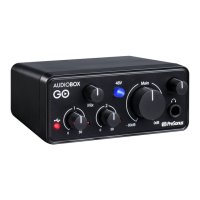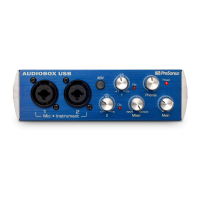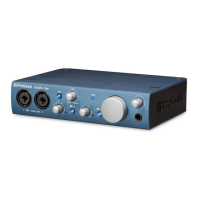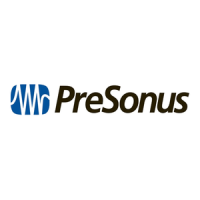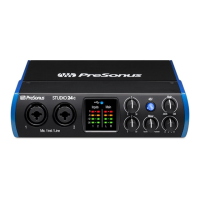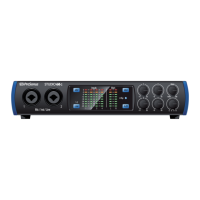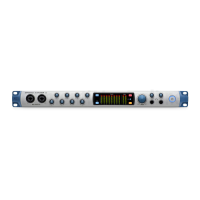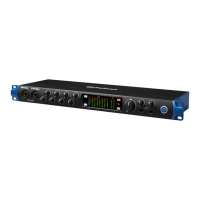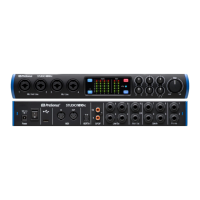Do you have a question about the PRESONUS AudioBox 22VSL and is the answer not in the manual?
Information on RoHS, REACH, WEEE, and CE compliance.
Welcome to the PreSonus AudioBox 22/44VSL and manual overview.
Summary of the device's physical and connectivity features.
Overview of bundled recording software features and capabilities.
Description of the monitor-mixing application for professional dynamics and effects.
Lists the items included in the AudioBox 22/44VSL package.
Details on the inputs, outputs, and controls on the front of the device.
Explains the ports and connections located on the back panel of the device.
Visual guide illustrating a typical setup for instruments, computer, and monitors.
Diagram showing how to connect MIDI devices for sequencing and control.
Minimum and recommended computer specifications for software compatibility.
Step-by-step guide for installing drivers and software on Windows operating systems.
Step-by-step guide for installing drivers and software on Mac OS X.
Setup instructions for integrating the AudioBox with common DAWs.
Introduction to the monitor-mixing software for controlling channel levels, Fat Channel, and effects.
Configuration options for VSL, including buffer size, sample rate, and meter settings.
Explains how to use the browser for managing Scenes, Fat Channel presets, and FX presets.
Describes the main VSL interface and how to access detailed Fat Channel parameters.
Explains various VSL controls like VSL On/Off, Select, Solo, Mute, and Fader.
Instructions on how to load and apply saved mix configurations and effect settings.
Guide on creating separate monitor mixes for performers using VSL's aux buses and effects.
Steps for installing and activating the bundled Studio One Artist DAW software.
How to ensure the AudioBox driver is correctly selected and active within Studio One Artist.
Steps for setting up external MIDI keyboards and sound modules within Studio One Artist.
Guide on starting a new project in Studio One Artist, including template selection and setup.
How to add and configure audio tracks within Studio One Artist for recording.
Instructions for adding and assigning MIDI tracks for virtual instruments and external sound modules.
Using drag-and-drop to add virtual instruments and effects to your project.
Explains different microphone types (dynamic, condenser, ribbon, USB) and their characteristics.
Guidance on positioning microphones for various instruments like pianos, guitars, and drums.
Introduction to dynamics processors like compressors and gates, explaining their function.
Explains core concepts of dynamic range, compression, and their necessity in mixing.
Detailed explanation of compression and limiting, including terminology like threshold and ratio.
Defines key compressor parameters such as Threshold, Ratio, and Limiter.
Explains expansion and noise gates, including their terminology and applications.
Details on how noise gates work, including settings like threshold, attack, hold, and release.
Provides suggested compression settings for vocals and percussion.
Basic explanation of equalization filters and their use in adjusting audio frequencies.
Describes shelving EQs for boosting or cutting frequencies above or below a cutoff point.
Explains graphic EQs and frequency ranges affecting sound characteristics.
Tips for effective EQ adjustment and general advice for mixing.
Provides example EQ settings for various instruments like vocals, drums, and guitars.
How to use aux buses for creating monitor mixes and processing external effects.
Creating custom monitor mixes for musicians, whether mono or stereo.
Using aux buses to apply effects like reverb to multiple channels simultaneously.
Overview of stereo effects processors, focusing on reverb and delay.
Explains reverb effect, its parameters (Decay, Predelay, HF/LF decay), and how it creates a sense of space.
Details the delay effect, including parameters like Delay Time and Variable Feedback for creating echoes.
Technical specifications for the AudioBox 22VSL interface.
Technical specifications for the AudioBox 44VSL interface.
Common technical issues and solutions for using the AudioBox and associated software.
Details of the product's limited warranty terms and conditions.
Information on RoHS, REACH, WEEE, and CE compliance.
Welcome to the PreSonus AudioBox 22/44VSL and manual overview.
Summary of the device's physical and connectivity features.
Overview of bundled recording software features and capabilities.
Description of the monitor-mixing application for professional dynamics and effects.
Lists the items included in the AudioBox 22/44VSL package.
Details on the inputs, outputs, and controls on the front of the device.
Explains the ports and connections located on the back panel of the device.
Visual guide illustrating a typical setup for instruments, computer, and monitors.
Diagram showing how to connect MIDI devices for sequencing and control.
Minimum and recommended computer specifications for software compatibility.
Step-by-step guide for installing drivers and software on Windows operating systems.
Step-by-step guide for installing drivers and software on Mac OS X.
Setup instructions for integrating the AudioBox with common DAWs.
Introduction to the monitor-mixing software for controlling channel levels, Fat Channel, and effects.
Configuration options for VSL, including buffer size, sample rate, and meter settings.
Explains how to use the browser for managing Scenes, Fat Channel presets, and FX presets.
Describes the main VSL interface and how to access detailed Fat Channel parameters.
Explains various VSL controls like VSL On/Off, Select, Solo, Mute, and Fader.
Instructions on how to load and apply saved mix configurations and effect settings.
Guide on creating separate monitor mixes for performers using VSL's aux buses and effects.
Steps for installing and activating the bundled Studio One Artist DAW software.
How to ensure the AudioBox driver is correctly selected and active within Studio One Artist.
Steps for setting up external MIDI keyboards and sound modules within Studio One Artist.
Guide on starting a new project in Studio One Artist, including template selection and setup.
How to add and configure audio tracks within Studio One Artist for recording.
Instructions for adding and assigning MIDI tracks for virtual instruments and external sound modules.
Using drag-and-drop to add virtual instruments and effects to your project.
Explains different microphone types (dynamic, condenser, ribbon, USB) and their characteristics.
Guidance on positioning microphones for various instruments like pianos, guitars, and drums.
Introduction to dynamics processors like compressors and gates, explaining their function.
Explains core concepts of dynamic range, compression, and their necessity in mixing.
Detailed explanation of compression and limiting, including terminology like threshold and ratio.
Defines key compressor parameters such as Threshold, Ratio, and Limiter.
Explains expansion and noise gates, including their terminology and applications.
Details on how noise gates work, including settings like threshold, attack, hold, and release.
Provides suggested compression settings for vocals and percussion.
Basic explanation of equalization filters and their use in adjusting audio frequencies.
Describes shelving EQs for boosting or cutting frequencies above or below a cutoff point.
Explains graphic EQs and frequency ranges affecting sound characteristics.
Tips for effective EQ adjustment and general advice for mixing.
Provides example EQ settings for various instruments like vocals, drums, and guitars.
How to use aux buses for creating monitor mixes and processing external effects.
Creating custom monitor mixes for musicians, whether mono or stereo.
Using aux buses to apply effects like reverb to multiple channels simultaneously.
Overview of stereo effects processors, focusing on reverb and delay.
Explains reverb effect, its parameters (Decay, Predelay, HF/LF decay), and how it creates a sense of space.
Details the delay effect, including parameters like Delay Time and Variable Feedback for creating echoes.
Technical specifications for the AudioBox 22VSL interface.
Technical specifications for the AudioBox 44VSL interface.
Common technical issues and solutions for using the AudioBox and associated software.
Details of the product's limited warranty terms and conditions.
| Product color | Blue, Silver |
|---|---|
| Sample rate | - kHz |
| Audio quality | 24 bit |
| Frequency range | 20 - 20000 Hz |
| Minimum RAM | 2048 MB |
| Minimum processor | Intel® Core™ Duo |
| Minimum storage drive space | 20000 MB |
| Compatible operating systems | Windows 7x 64/x86 SP1 or Windows 8/8.1 x64/x86, Windows 10 x64/x86, Mac® OS X 10.8 or later |
| Microphone input impedance | 17000 Ω |
| Microphone Total Harmonic Distortion (THD) | 0.005 % |
| Headphones sampling rates | 20 kHz |
| USB powered | Yes |
| Signal-to-Noise Ratio (SNR) | 89 dB |
| Total Harmonic Distortion (THD) | 0.006 % |
| Weight | 700 g |
|---|---|
| Dimensions (WxDxH) | 139.7 x 139.7 x 44.5 mm |
